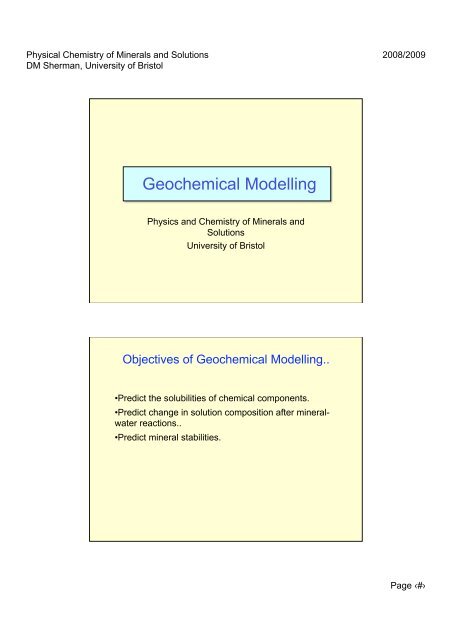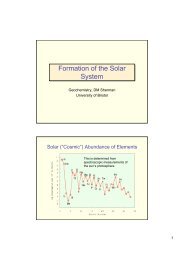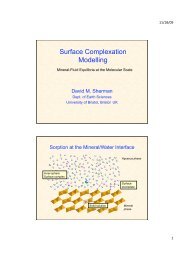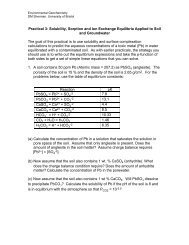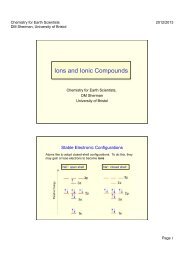Introduction to Geochemical Modelling - University of Bristol
Introduction to Geochemical Modelling - University of Bristol
Introduction to Geochemical Modelling - University of Bristol
Create successful ePaper yourself
Turn your PDF publications into a flip-book with our unique Google optimized e-Paper software.
Physical Chemistry <strong>of</strong> Minerals and SolutionsDM Sherman, <strong>University</strong> <strong>of</strong> Bris<strong>to</strong>l2008/2009<strong>Geochemical</strong> <strong>Modelling</strong>Physics and Chemistry <strong>of</strong> Minerals andSolutions<strong>University</strong> <strong>of</strong> Bris<strong>to</strong>lObjectives <strong>of</strong> <strong>Geochemical</strong> <strong>Modelling</strong>..•Predict the solubilities <strong>of</strong> chemical components.•Predict change in solution composition after mineralwaterreactions..•Predict mineral stabilities.Page ‹#›
Physical Chemistry <strong>of</strong> Minerals and SolutionsDM Sherman, <strong>University</strong> <strong>of</strong> Bris<strong>to</strong>l2008/2009Method..•Define the unique (“basis” ) species that define thecomposition (i.e., the components).•Consider all <strong>of</strong> the species that might form from thatbasis.•Set up the mass-action law for each species.•Set up the mass or charge balance constraint.•Solve the simultaneous equations...Example: ZnS in 0.1m NaCl, pH = 3•Define a set <strong>of</strong> “basis” species (components) thatdefine the compositional variations <strong>of</strong> the system:Zn +2 , H 2 S, Cl - , H + , Na +•Consider all <strong>of</strong> the other species that might form fromthat basis:ZnS(s) + H + = Zn +2 + HS-Zn +2 + Cl - = ZnCl-Zn +2 + 2Cl - = ZnCl 2-HS- + H + = H 2 S(Note: each equilibrium must be unique so that onereaction cannot be a sum <strong>of</strong> two others.)Page ‹#›
Physical Chemistry <strong>of</strong> Minerals and SolutionsDM Sherman, <strong>University</strong> <strong>of</strong> Bris<strong>to</strong>l2008/2009Example: Solubility <strong>of</strong> ZnS•Write mass action expressions for each species:[Zn +2 ][HS " ][H + ]= 10 "1.46[H + ][HS " ][H 2S]= 10 " ?![ZnCl + ][Zn +2 ][Cl " ] = 10"6.3 !![ZnCl 2][Zn +2 ][Cl " ] 2 = 10"10.33!Example: Solubility <strong>of</strong> ZnS•Write mass conservation for each componentCl <strong>to</strong>t = [Cl-] + [ZnCl + ] + 2[ZnCl 2- ] = 0.1 mNa <strong>to</strong>t = [Na + ] = 0.1 m[H + ] = 10 -3Write charge conservation:2[Zn +2 ] + [H+] + [ZnCl + ] + [Na + ]= [Cl-] + [HS - ] + [ZnCl 2- ]Page ‹#›
Physical Chemistry <strong>of</strong> Minerals and SolutionsDM Sherman, <strong>University</strong> <strong>of</strong> Bris<strong>to</strong>l2008/2009Example: Solubility <strong>of</strong> ZnSWe have 8 unknowns and 8 equations. However, theequations are non-linear!Moreover, we are ignoring the activity coefficientswhich cannot be determined until we know theconcentrations <strong>of</strong> all the charged species.But these cannot be determined until we know theactivity coefficients..!Popular Computer Programs•PHREEQC (U.S. Geological Survey)•MINTEQ (US EPA)•Geochemist’s Workbench (<strong>University</strong> <strong>of</strong> Illinois)•EQ3 (Lawrence Livermore National Lab)Page ‹#›
Physical Chemistry <strong>of</strong> Minerals and SolutionsDM Sherman, <strong>University</strong> <strong>of</strong> Bris<strong>to</strong>l2008/2009ZnS solubility using PHREEQCHere is the input file for our problem:TITLE ZnS solubility on 0.1 m NaClSOLUTIONpH 3.0units mol/kgwNa 0.1Cl 0.1EQUILIBRIUM_PHASESSphalerite 0.0 1.0ENDWe have two blocks: one (SOLUTION) <strong>to</strong> specify theinitial solution composition and the other(EQUILIBRIUM_PHASES) <strong>to</strong> constrain which phases willbe present.ZnS solubility using PHREEQCThe output file for our problem contains the <strong>to</strong>tal dissolvedZn and the speciation <strong>of</strong> Zn:Log Log LogSpecies Molality Activity Molality Activity GammaZn 9.439e-06Zn+2 8.815e-06 3.560e-06 -5.055 -5.449 -0.394ZnCl+ 5.798e-07 4.501e-07 -6.237 -6.347 -0.110ZnCl2 3.956e-08 3.956e-08 -7.403 -7.403 0.000ZnCl4-2 2.656e-09 9.377e-10 -8.576 -9.028 -0.452ZnCl3- 2.118e-09 1.644e-09 -8.674 -8.784 -0.110So, we find that <strong>to</strong>tal dissolved zinc is 9.4x10 -6 m (0.61ppm) and that most <strong>of</strong> the Zn is uncomplexed by Cl- (e.g.,as Zn(H 2 O) 6+2).Page ‹#›
Physical Chemistry <strong>of</strong> Minerals and SolutionsDM Sherman, <strong>University</strong> <strong>of</strong> Bris<strong>to</strong>l2008/2009ZnS solubility using PHREEQCOur calculation uses a thermodynamic “database” whichcontains log K and ΔH for different complex formation andmineral dissolution reactions:SOLUTION_SPECIES1.0000 Zn++ + 1.0000 Cl- = ZnCl+-llnl_gamma 4.0log_k +0.1986-delta_H 43.317 kJ/mol-analytic 1.1235e+002 4.4461e-002 -4.1662e+003 -4.5023e+001 -6.5042e+001# -Range: 0-300PHASESSphaleriteZnS +1.0000 H+ = + 1.0000 HS- + 1.0000 Zn++log_k -11.4400-delta_H 35.5222 kJ/mol # Enthalpy-analytic -1.5497e+002 -4.8953e-002 1.7850e+003 6.1472e+0012.7899e+001# -Range: 0-300ZnS solubility using PHREEQCIf there is are ΔH values for all our species/minerals,we can calculate solubilities at temperatures otherthan that <strong>of</strong> the default <strong>of</strong> 25 ºC:TITLE ZnS solubility on 0.1 m NaClSOLUTIONpH 3.0Temp 250units mol/kgwNa 0.1Cl 0.1EQUILIBRIUM_PHASESSphalerite 0.0 1.0ENDPage ‹#›
Physical Chemistry <strong>of</strong> Minerals and SolutionsDM Sherman, <strong>University</strong> <strong>of</strong> Bris<strong>to</strong>l2008/2009Batch Reaction Model Example (Cont.)First, PHREEQC solves for the solution speciation:----------------------------Distribution <strong>of</strong> species----------------------------Log Log LogSpecies Molality Activity Molality Activity GammaAlH(0)KO(0)SiH+ 3.189e-07 3.162e-07 -6.496 -6.500 -0.004OH- 3.192e-08 3.166e-08 -7.496 -7.500 -0.004H2O 5.551e+01 1.000e+00 0.000 0.000 0.0001.853e-06Al(OH)4- 1.202e-06 1.192e-06 -5.920 -5.924 -0.004Al(OH)2+ 4.328e-07 4.292e-07 -6.364 -6.367 -0.004Al(OH)3 2.000e-07 2.000e-07 -6.699 -6.699 0.000AlOH+2 1.791e-08 1.732e-08 -7.747 -7.762 -0.015Al+3 5.940e-10 5.513e-10 -9.226 -9.259 -0.0321.416e-24H2 7.079e-25 7.079e-25 -24.150 -24.150 0.0001.023e-04K+ 1.023e-04 1.014e-04 -3.990 -3.994 -0.004KOH 1.112e-12 1.112e-12 -11.954 -11.954 0.0000.000e+00O2 0.000e+00 0.000e+00 -44.080 -44.080 0.0006.657e-05H4SiO4 6.654e-05 6.654e-05 -4.177 -4.177 0.000H3SiO4- 3.129e-08 3.103e-08 -7.505 -7.508 -0.004H2SiO4-2 6.902e-15 6.674e-15 -14.161 -14.176 -0.015Batch Reaction Model Example (Cont.)Next, PHREEQC calculates the thesaturation index for each possiblemineral:S.I. = log Q K------------------------------Saturation indices-------------------------------PhaseSI log IAP log KTAl(OH)3(a) -0.56 10.24 10.80 Al(OH)3Chalcedony -0.63 -4.18 -3.55 SiO2Gibbsite 2.13 10.24 8.11 Al(OH)3H2(g) -21.00 -21.00 0.00 H2K-feldspar -1.88 0.22 2.09 KAlSi3O8K-mica 8.00 20.70 12.70 KAl3Si3O10(OH)2Kaolinite 4.69 12.13 7.43 Al2Si2O5(OH)4O2(g) -41.12 42.00 83.12 O2Quartz -0.20 -4.18 -3.98 SiO2SiO2(a) -1.47 -4.18 -2.71 SiO2!We are oversaturated (SI > 0) in several minerals;with time, they would precipitate out. However, it ismore complicated than that..Page ‹#›
Physical Chemistry <strong>of</strong> Minerals and SolutionsDM Sherman, <strong>University</strong> <strong>of</strong> Bris<strong>to</strong>l2008/2009Batch Reaction Model Example (Cont.)Now we can let the solution equilibrate with K-feldsparand see what happens. We constrained the reactionso that K-mica is not allowed <strong>to</strong> precipitate out sincethat is kinetically slow..-----------------------------Phase assemblage--------------------------------Moles in assemblagePhase SI log IAP log KT Initial Final DeltaK-feldspar 0.00 2.09 2.09 1.000e+01 1.000e+01 -1.107e-04K-mica 4.20 16.90 12.70 0.000e+00 0.000e+00Kaolinite 0.00 7.44 7.43 0.000e+00 5.550e-05 5.550e-05The solution will react with K-feldspar <strong>to</strong> producekaolinite..Batch Reaction Model Example (Cont.)Solution composition after reacting with feldspar..----------------------------Distribution <strong>of</strong> species----------------------------Log Log LogSpecies Molality Activity Molality Activity GammaAlH(0)KO(0)SiOH- 2.725e-05 2.685e-05 -4.565 -4.571 -0.006H+ 3.782e-10 3.728e-10 -9.422 -9.429 -0.006H2O 5.551e+01 1.000e+00 0.000 0.000 0.0001.497e-06Al(OH)4- 1.497e-06 1.475e-06 -5.825 -5.831 -0.006Al(OH)3 2.917e-10 2.917e-10 -9.535 -9.535 0.000Al(OH)2+ 7.491e-13 7.381e-13 -12.125 -12.132 -0.006AlOH+2 3.723e-17 3.511e-17 -16.429 -16.455 -0.026Al+3 1.500e-21 1.318e-21 -20.824 -20.880 -0.0562.023e-30H2 1.012e-30 1.012e-30 -29.995 -29.995 0.0002.130e-04K+ 2.129e-04 2.098e-04 -3.672 -3.678 -0.006KOH 1.952e-09 1.952e-09 -8.710 -8.710 0.0008.147e-33O2 4.074e-33 4.074e-33 -32.390 -32.390 0.0002.875e-04H4SiO4 2.052e-04 2.052e-04 -3.688 -3.688 0.000H3SiO4- 8.235e-05 8.115e-05 -4.084 -4.091 -0.006H2SiO4-2 1.570e-08 1.481e-08 -7.804 -7.830 -0.026Page ‹#›
Physical Chemistry <strong>of</strong> Minerals and SolutionsDM Sherman, <strong>University</strong> <strong>of</strong> Bris<strong>to</strong>l2008/2009Summary•Mass-action constraint <strong>to</strong> relate different species(simultaneous equilibria).•Mass conservation constraint.•We solve simultaneous non-linear equations.•Kinetic effects can be accounted for by imposingundersaturation or oversaturation..Page ‹#›


